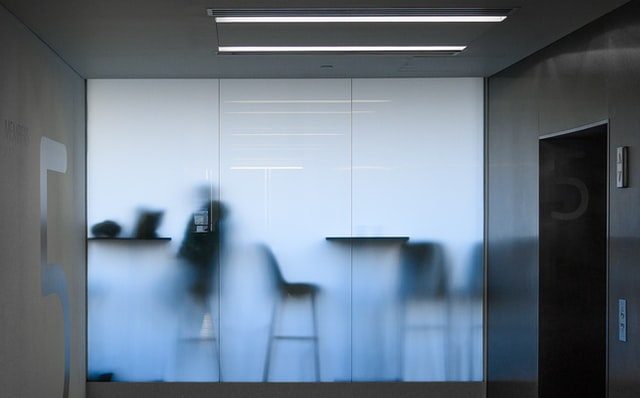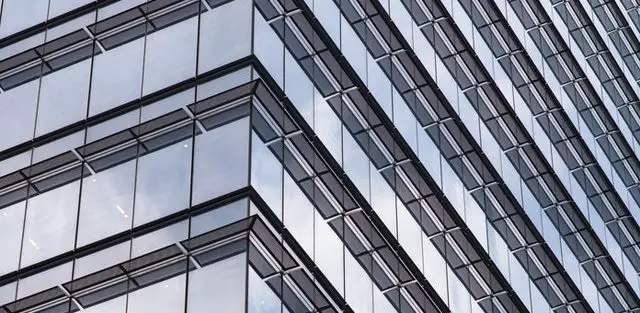A smart glass window is a type of glass that you can use to block light, insulate, or both. An external force controls the ability of the window to transmit light. In most cases, people can activate smart glass by applying electricity, heat, or light to it. The pane turns from transparent to translucent or opaque. Other names that refer to the same glass include light control glass, privacy glass, smart tint, dynamic glass, tintable glass, and switchable glass.
The technology arose out of necessity. People wanted a way to keep using glass while maintaining privacy. The benefits of privacy glass have made it very popular for commercial applications. Commercial buildings are the largest market for smart glass products.
What Are Smart Glass Windows?
A smart glass window is a type of glass that can be used to block light, insulate, or both. An external force, such as electricity or heat, controls the ability of the window to transmit light.

Types Of Smart Glass
The two broad categories of smart glass include active and passive.
You need an electric current to operate active smart glass, but passive panels don’t use electricity.
There are three sub-categories of active privacy glass: Polymer Dispersed Liquid Crystal, Electrochromic, and Suspended Particle Device.
1 | Polymer Dispersed Liquid Crystal (PDLC) Smart Glass Window
This type of glass dominates privacy areas such as ICU areas, bathrooms, and conference rooms. The PDLC glass contains dissolved liquid crystals suspended in a polymer.
The crystals remain suspended because they are incompatible with the other materials hence do not clamp together. When they are scattered, they disperse light and look translucent.
If you apply electricity to the glass, crystals in it align to allow more light to pass. As a result, the glass becomes transparent.
2 | Suspended Particle Glass
Particles of liquid crystal float randomly in this panel and block or absorb light. Their orientation disperses light and gives the glass a translucent appearance. You can apply varying voltages to achieve different levels of opacity.
This glass differs from PDLC because you can change the intensity of its opacity. Several devices can serve this purpose, including photosensors, apps, knobs, motion detectors, and computers.
3 | Electrochromic Smart Glass Window
The properties of this windowpane change slowly when an electric current flows through it. When you attain the level of opacity you want, you can disconnect the electricity and will not lose the effect. You can control how slowly the smart glass window changes.
This glass is commonly used in museum display cases, rearview mirrors, and building windows. One weakness of this glass is that it is not as durable as the other technologies.
4 | Photochromic Smart Glass Window
It is the first type of passive smart glass window. Instead of relying on electricity to activate, photochromic glass uses light. Specifically, the glass becomes tinted when ultraviolet light hits it. Very high-intensity beams of light can also make the glass tint.
The most popular use of this glass is eyeglasses.
5 | Thermochromic Glass
As the name suggests, this glass turns when it becomes warmer or cooler. The opacity of this glass changes when its temperature exceeds a threshold. This level is called the transition temperature. The effect happens gradually.

Advantages Of The Smart Glass Window
Energy Savings
A smart glass window reflects sunlight and keeps the internal building temperature low. The glass can reflect up to 40 percent of the heat that strikes it. As a result, the air conditioning does not need to work very hard to maintain the building’s temperature.
You recoup the initial cost of this glass in the long run from the energy savings it provides.
Science Daily reports the significant energy savings provided by the smart glass. Buildings fitted with smart glass can use up to 35 percent less energy than conventional buildings. Additionally, smart glass during construction can reduce their steel and concrete usage by 10 percent.
Versatility
There are numerous places where you can use the smart glass window. Since the glass does not have to be flat, you can come up with creative ideas that will give your buildings a unique look.
Security Barriers
Switchable glass can give you privacy instantly with the flick of a button. It is ideal for areas where you need privacy but not all the time.
You can get these glass panels with varying properties. For instance, glass panels for security applications could be fire-retardant, blast-resistant, or bulletproof to improve security.
Protects You From Sunlight
A smart glass window designed to block sunlight can block harmful ultraviolet light. While letting light through, this glass can block up to 99% of ultraviolet radiation.
Sound Isolation
A little-known feature of the smart glass window is sound insulation. The type of glass can attenuate up to 39 decibels of noise.
Sound insulating glass is ideal for conference centres, board rooms, and any commercial space where you do not want the sound to come through.
It Is Environmentally Friendly
There is an increasing urgency to make buildings, particularly commercial ones, more friendly to the environment. Designers of modern office buildings are already incorporating smart glass into their projects.
The glass also helps builders of commercial buildings to comply with the legislation and protect the environment.
Cost-Efficient
Smart glass windows do not cost the same as regular panels. In fact, they are costlier. However, over time, the energy savings you gain offset the initial cost and even take you into profitable territory.
The cost of maintaining privacy glass is also lower than that of conventional glass.
It Increases A Building's Market Value
A commercial building with smart glass for its facade can sell for more money than one with regular windows. Installing these windows on buildings for rent or sale increases your rate of return on investment.
Visual appeal
Switchable glass does not have to be boring. Most people think that a smart glass window can only turn from transparent to translucent. However, the glass can turn into any colour that the manufacturer wants.
In places like museums and art galleries, coloured glass is usually preferable. These places like to use bold and colourful glass.
Disadvantages Of The Smart Glass Window
High Up-Front Costs
Switchable glass remains quite costly despite its increasing popularity. If you install smart glass to reduce energy costs, it takes a long time to save enough to cover the cost.
The high cost of this glass means that the only place it makes financial sense is in office buildings, hotels, retail stores, or high-end residential properties.
It Needs Electricity To Operate
Even though it can help you with significant energy savings, a smart glass window needs electricity to work. If you are in an area where the electricity is unreliable, you might be unable to use it effectively.
Difficult To Install
Only skilled people can install a smart glass window. They must have expertise in installing windows as well as electrical installation.
Electrical Consumption
Although smart glass can reduce a building’s energy needs, they also use electricity. Typically, an electrochromic glass pane needs between 3 and 5 watts of power per square meter.
It might not sound like a lot; however, it adds up if you want to install the glass over a large area. You might be better off choosing passive smart glass instead.
It Can Be Hard To Find
A smart glass window has many benefits for commercial or residential uses. However, the technology is not widely available. Depending on your location, you might have difficulty finding a store that sells it.
Commercial Applications Of Smart Glass
Because of its cost and benefits, a smart glass window is more suited for commercial buildings. The following are some places where you can find these windows.
- Hospitals and clinics: More hospitals are discontinuing fabric dividers in favor of glass. It is more hygienic, durable, and private.
- In schools: The COVID-19 pandemic has forced schools to separate people without ruining the aesthetics. Solid walls could block natural light. Therefore, the best alternative is smart glass.
- In retail spaces: Most street-facing retail stores need to display items to attract shoppers to the store. However, when store attendants are staging the display items or the store is closed, a smart glass window can hide the area.
- Conference rooms: The need for privacy in conference rooms make them a no-brainer for smart glass window installation.
- Hotels: Guest bedrooms need to look luxurious and spacious. Hotel designers, therefore, use smart glass to separate areas such as bathrooms, toilets, external doors, and windows.

Conclusion
From its humble beginning, the smart glass window is now part of many modern buildings. The glass brings a mix of functionality and aesthetics that is hard to match.
Commercial buildings that use smart glass in their facades outshine their competitors when it comes to sustainability.
If you want to learn more about sustainability, smart buildings & cities, commercial real estate, and PropTech, feel free to take a look at our other blog articles.
